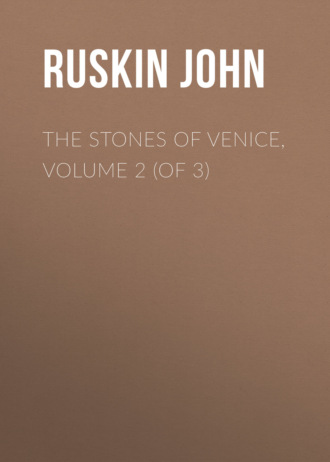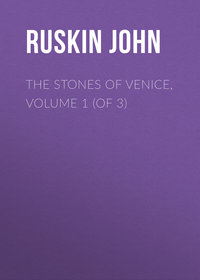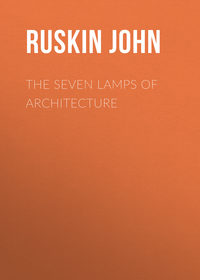 полная версия
полная версияThe Stones of Venice, Volume 2 (of 3)
On the other side of this palace is the Traghetto called “Della Madonnetta;” and beyond this Traghetto, still facing the Grand Canal, a small palace, of which the front shows mere vestiges of arcades, the old shafts only being visible, with obscure circular seams in the modern plaster which covers the arches. The side of it is a curious agglomeration of pointed and round windows in every possible position, and of nearly every date from the twelfth to the eighteenth century. It is the smallest of the buildings we have to examine, but by no means the least interesting: I shall call it, from the name of its Traghetto, the Madonnetta House.
(5.) The Rio Foscari HouseWe must now descend the Grand Canal as far as the Palazzo Foscari, and enter the narrower canal, called the Rio di Ca’ Foscari, at the side of that palace. Almost immediately after passing the great gateway of the Foscari courtyard, we shall see on our left, in the ruinous and time-stricken walls which totter over the water, the white curve of a circular arch covered with sculpture, and fragments of the bases of small pillars, entangled among festoons of the Erba della Madonna. I have already, in the folio plates which accompanied the first volume, partly illustrated this building. In what references I have to make to it here, I shall speak of it as the Rio Foscari House.
(6.) Casa FarsettiWe have now to reascend the Grand Canal, and approach the Rialto. As soon as we have passed the Casa Grimani, the traveller will recognize, on his right, two rich and extensive masses of building, which form important objects in almost every picturesque view of the noble bridge. Of these, the first, that farthest from the Rialto, retains great part of its ancient materials in a dislocated form. It has been entirely modernized in its upper stories, but the ground floor and first floor have nearly all their original shafts and capitals, only they have been shifted hither and thither to give room for the introduction of various small apartments, and present, in consequence, marvellous anomalies in proportion. This building is known in Venice as the Casa Farsetti.
(7.) Casa LoredanThe one next to it, though not conspicuous, and often passed with neglect, will, I believe, be felt at last, by all who examine it carefully, to be the most beautiful palace in the whole extent of the Grand Canal. It has been restored often, once in the Gothic, once in the Renaissance times,—some writers say, even rebuilt; but, if so, rebuilt in its old form. The Gothic additions harmonize exquisitely with its Byzantine work, and it is easy, as we examine its lovely central arcade, to forget the Renaissance additions which encumber it above. It is known as the Casa Loredan.
The eighth palace is the Fondaco de’ Turchi, described in the text. A ninth existed, more interesting apparently than any of these, near the Church of San Moisè, but it was thrown down in the course of “improvements” a few years ago. A woodcut of it is given in M. Lazari’s Guide.
12. MODERN PAINTING ON GLASS
Of all the various principles of art which, in modern days, we have defied or forgotten, none are more indisputable, and few of more practical importance than this, which I shall have occasion again and again to allege in support of many future deductions:
“All art, working with given materials, must propose to itself the objects which, with those materials, are most perfectly attainable; and becomes illegitimate and debased if it propose to itself any other objects, better attainable with other materials.”
Thus, great slenderness, lightness, or intricacy of structure,—as in ramifications of trees, detached folds of drapery, or wreaths of hair,—is easily and perfectly expressible in metal-work or in painting, but only with great difficulty and imperfectly expressible in sculpture. All sculpture, therefore, which professes as its chief end the expression of such characters, is debased; and if the suggestion of them be accidentally required of it, that suggestion is only to be given to an extent compatible with perfect ease of execution in the given material,—not to the utmost possible extent. For instance: some of the most delightful drawings of our own water-color painter, Hunt, have been of birds’ nests; of which, in painting, it is perfectly possible to represent the intricate fibrous or mossy structure; therefore, the effort is a legitimate one, and the art is well employed. But to carve a bird’s nest out of marble would be physically impossible, and to reach any approximate expression of its structure would require prolonged and intolerable labor. Therefore, all sculpture which set itself to carving birds’ nests as an end, or which, if a bird’s nest were required of it, carved it to the utmost possible point of realization, would be debased. Nothing but the general form, and as much of the fibrous structure as could be with perfect ease represented, ought to be attempted at all.
But more than this. The workman has not done his duty, and is not working on safe principles, unless he even so far honors the materials with which he is working as to set himself to bring out their beauty, and to recommend and exalt, as far as lie can, their peculiar qualities. If he is working in marble, he should insist upon and exhibit its transparency and solidity; if in iron, its strength and tenacity; if in gold, its ductility; and he will invariably find the material grateful, and that his work is all the nobler for being eulogistic of the substance of which it is made. But of all the arts, the working of glass is that in which we ought to keep these principles most vigorously in mind. For we owe it so much, and the possession of it is so great a blessing, that all our work in it should be completely and forcibly expressive of the peculiar characters which give it so vast a value.
These are two, namely, its DUCTILITY when heated, and TRANSPARENCY when cold, both nearly perfect. In its employment for vessels, we ought always to exhibit its ductility, and in its employment for windows, its transparency. All work in glass is bad which does not, with loud voice, proclaim one or other of these great qualities.
Consequently, all cut glass is barbarous: for the cutting conceals its ductility, and confuses it with crystal. Also, all very neat, finished, and perfect form in glass is barbarous: for this fails in proclaiming another of its great virtues; namely, the ease with which its light substance can be moulded or blown into any form, so long as perfect accuracy be not required. In metal, which, even when heated enough to be thoroughly malleable, retains yet such weight and consistency as render it susceptible of the finest handling and retention of the most delicate form, great precision of workmanship is admissible; but in glass, which when once softened must be blown or moulded, not hammered, and which is liable to lose, by contraction or subsidence, the fineness of the forms given to it, no delicate outlines are to be attempted, but only such fantastic and fickle grace as the mind of the workman can conceive and execute on the instant. The more wild, extravagant, and grotesque in their gracefulness the forms are, the better. No material is so adapted for giving full play to the imagination, but it must not be wrought with refinement or painfulness, still less with costliness. For as in gratitude we are to proclaim its virtues, so in all honesty we are to confess its imperfections; and while we triumphantly set forth its transparency, we are also frankly to admit its fragility, and therefore not to waste much time upon it, nor put any real art into it when intended for daily use. No workman ought ever to spend more than an hour in the making of any glass vessel.
Next in the case of windows, the points which we have to insist upon are, the transparency of the glass and its susceptibility of the most brilliant colors; and therefore the attempt to turn painted windows into pretty pictures is one of the most gross and ridiculous barbarisms of this pre-eminently barbarous century. It originated, I suppose, with the Germans, who seem for the present distinguished among European nations by the loss of the sense of color; but it appears of late to have considerable chance of establishing itself in England: and it is a two-edged error, striking in two directions; first at the healthy appreciation of painting, and then at the healthy appreciation of glass. Color, ground with oil, and laid on a solid opaque ground, furnishes to the human hand the most exquisite means of expression which the human sight and invention can find or require. By its two opposite qualities, each naturally and easily attainable, of transparency in shadow and opacity in light, it complies with the conditions of nature; and by its perfect governableness it permits the utmost possible fulness and subtlety in the harmonies of color, as well as the utmost perfection in the drawing. Glass, considered as a material for a picture, is exactly as bad as oil paint is good. It sets out by reversing the conditions of nature, by making the lights transparent and the shadows opaque; and the ungovernableness of its color (changing in the furnace), and its violence (being always on a high key, because produced by actual light), render it so disadvantageous in every way, that the result of working in it for pictorial effect would infallibly be the destruction of all the appreciation of the noble qualities of pictorial color.
In the second place, this modern barbarism destroys the true appreciation of the qualities of glass. It denies, and endeavors as far as possible to conceal, the transparency, which is not only its great virtue in a merely utilitarian point of view, but its great spiritual character; the character by which in church architecture it becomes most touchingly impressive, as typical of the entrances of the Holy Spirit into the heart of man; a typical expression rendered specific and intense by the purity and brilliancy of its sevenfold hues;161 and therefore in endeavoring to turn the window into a picture, we at once lose the sanctity and power of the noble material, and employ it to an end which is utterly impossible it should ever worthily attain. The true perfection of a painted window is to be serene, intense, brilliant, like flaming jewellery; full of easily legible and quaint subjects, and exquisitely subtle, yet simple, in its harmonies. In a word, this perfection has been consummated in the designs, never to be surpassed, if ever again to be approached by human art, of the French windows of the twelfth and thirteenth centuries.
1
Appendix 1, “The Gondolier’s Cry.”
2
Appendix 2, “Our Lady of Salvation.”
3
Appendix 3, “Tides of Venice.”
4
Appendix 4, “Date of the Duomo of Torcello.”
5
For a full account of the form and symbolical meaning of the Basilica, see Lord Lindsay’s “Christian Art,” vol. i. p. 12. It is much to be regretted that the Chevalier Bunsen’s work on the Basilicas of Rome is not translated into English.
6
The measures are given in Appendix 3.
7
Hope’s “Historical Essay on Architecture” (third edition, 1840), chap. ix. p. 95. In other respects Mr. Hope has done justice to this building, and to the style of the early Christian churches in general.
8
A sketch has been given of this capital in my folio work.
9
Appendix 5, “Modern Pulpits.”
10
“Mela, e buon vino, con pace e carità,” Memorie Storiche de’ Veneti Primi e Secondi, di Jacopo Filiasi (Padua, 1811), tom. iii. cap. 23. Perhaps, in the choice of the abbot’s cheer, there was some occult reference to the verse of Solomon’s Song: “Stay me with flagons, comfort me with apples.”
11
Notizie Storiche delle Chiese di Venezia, illustrate da Flaminio Corner (Padua, 1758), p. 615.
12
“On the 14th day of April, 1374, there were found, in this church of the first martyr St. Stefano, two hundred and more bodies of holy martyrs, by the venerable priest, Matthew Fradello, incumbent of the church.”
13
Notizie Storiche, p. 620.
14
The intention is farther confirmed by the singular variation in the breadth of the small fillet which encompasses the inner marble. It is much narrower at the bottom than at the sides, so as to recover the original breadth in the lower border.
15
Its elevation is given to scale in fig. 4, Plate XIII., below.
16
“Luogo de’ ninfe e de’ semidei.”—M. Andrea Calmo, quoted by Mutinelli, Annali Urbani di Venezia (Venice, 1841), p. 362.
17
“The women, even as far back as 1100, wore dresses of blue, with mantles on the shoulder, which clothed them before and behind.”—Sansorino.
It would be difficult to imagine a dress more modest and beautiful. See Appendix 7.
18
“Whom Eve destroyed, the pious Virgin Mary redeemed;All praise her, who rejoice in the Grace of Christ.”Vide Appendix 8.
19
Acts, xiii. 13; xv. 38, 39.
20
The reader who desires to investigate it may consult Galliciolli, “Delle Memorie Venete” (Venice, 1795), tom. ii. p. 332, and the authorities quoted by him.
21
Venice, 1761, tom. i. p. 126.
22
St. Mark’s Place, “partly covered by turf, and planted with a few trees; and on account of its pleasant aspect called Brollo or Broglio, that is to say, Garden.” The canal passed through it, over which is built the bridge of the Malpassi, Galliciolli, lib. i. cap. viii.
23
My authorities for this statement are given below, in the chapter on the Ducal Palace.
24
In the Chronicles, “Sancti Marci Ducalis Cappella.”
25
“To God the Lord, the glorious Virgin Annunciate, and the Protector St. Mark.”—Corner, p. 14. It is needless to trouble the reader with the various authorities for the above statements: I have consulted the best. The previous inscription once existing on the church itself:
“Anno milleno transacto bisque trigenoDesuper undecimo fuit facta primo,”is no longer to be seen, and is conjectured by Corner, with much probability, to have perished “in qualche ristauro.”
26
Signed Bartolomeus Bozza, 1634, 1647, 1656, &c.
27
Guida di Venezia, p. 6.
28
The mere warmth of St. Mark’s in winter, which is much greater than that of the other two churches above named, must, however, be taken into consideration, as one of the most efficient causes of its being then more frequented.
29
I said above that the larger number of the devotees entered by the “Arabian” porch; the porch, that is to say, on the north side of the church, remarkable for its rich Arabian archivolt, and through which access is gained immediately to the northern transept. The reason is, that in that transept is the chapel of the Madonna, which has a greater attraction for the Venetians than all the rest of the church besides. The old builders kept their images of the Virgin subordinate to those of Christ; but modern Romanism has retrograded from theirs, and the most glittering portions of the whole church are the two recesses behind this lateral altar, covered with silver hearts dedicated to the Virgin.
30
Vide “Builder,” for October, 1851.
31
“Quivi presso si vedi una colonna di tanta bellezza e finezza che e riputato piutosto gioia che pietra.”—Sansovino, of the verd-antique pillar in San Jacomo dell’ Orio. A remarkable piece of natural history and moral philosophy, connected with this subject, will be found in the second chapter of our third volume, quoted from the work of a Florentine architect of the fifteenth century.
32
The fact is, that no two tesseræ of the glass are exactly of the same tint, the greens being all varied with blues, the blues of different depths, the reds of different clearness, so that the effect of each mass of color is full of variety, like the stippled color of a fruit piece.
33
Some illustration, also, of what was said in § XXXIII. above, respecting the value of the shafts of St. Mark’s as large jewels, will be found in Appendix 9, “Shafts of St. Mark’s.”
34
See the farther notice of this subject in Vol. III. Chap. IV.
35
I do not mean that modern Christians believe less in the facts than ancient Christians, but they do not believe in the representation of the facts as true. We look upon the picture as this or that painter’s conception; the elder Christians looked upon it as this or that painter’s description of what had actually taken place. And in the Greek Church all painting is, to this day, strictly a branch of tradition. See M. Dideron’s admirably written introduction to his Iconographie Chrétienne, p. 7:—“Un de mes compagnons s’étonnait de retrouver à la Panagia de St. Luc, le saint Jean Chrysostome qu’il avait dessiné dans le baptistère de St. Marc, à Venise. Le costume des personnages est partout et en tout temps le même, non-seulement pour la forme, mais pour la couleur, mais pour le dessin, mais jusque pour le nombre et l’épaisseur des plis.”
36
All the effects of Byzantine art to represent violent action are inadequate, most of them ludicrously so, even when the sculptural art is in other respects far advanced. The early Gothic sculptors, on the other hand, fail in all points of refinement, but hardly ever in expression of action. This distinction is of course one of the necessary consequences of the difference in all respects between the repose of the Eastern, and activity of the Western, mind, which we shall have to trace out completely in the inquiry into the nature of Gothic.
37
Appendix 10, “Proper Sense of the word Idolatry.”
38
It is also of inferior workmanship, and perhaps later than the rest. Vide Lord Lindsay, vol. i. p. 124, note.
39
The old mosaics from the Revelation have perished, and have been replaced by miserable work of the seventeenth century.
40
Rev. xxi. 18.
41
In the year 1851, by the Duchesse de Berri.
42
Of the Braided House and Casa Businello, described in the Appendix, only the great central arcades remain.
43
By Mr. Penrose.
44
I am sometimes obliged, unfortunately, to read my woodcuts backwards owing to my having forgotten to reverse them on the wood.
45
Vide Plate X. figs. 1 and 4.
46
1. Fondaco de’ Turehi, lateral pillars.
2. Terraced House, lateral pillars.
3. Casa Farsetti, central pillars, upper arcade.
4. Casa Loredan, lower arcade.
5. Casa Loredan, lower arcade.
6. Fondaco de’ Turchi, upper arcade.
7. Casa Loredan, upper arcade.
8. St. Mark’s.
9. St. Mark’s.
10. Braided House, upper arcade.
11. Casa Loredan, upper arcade.
12. St. Mark’s.
13. St. Mark’s.
14. Fondaco de’ Turchi, upper arcade.
15. St. Mark’s.
47
Compare “Seven Lamps,” chap. ii. § 22.
48
Two of these are represented in the second number of my folio work upon Venice.
49
The absence of the true grotesque spirit in Byzantine work will be examined in the third chapter of the third volume.
50
Ezekiel, xxvii. 11.
51
Perhaps this type is in no place of Scripture more touchingly used than in Lamentations, i. 12, where the word “afflicted” is rendered in the Vulgate “vindemiavit,” “vintaged.”
52
Appendix 12, “Modern Painting on Glass.”
53
2 Samuel, xiii. 18.
54
The third kind of ornament, the Renaissance, is that in which the inferior detail becomes principal, the executor of every minor portion being required to exhibit skill and possess knowledge as great as that which is possessed by the master of the design; and in the endeavor to endow him with this skill and knowledge, his own original power is overwhelmed, and the whole building becomes a wearisome exhibition of well-educated imbecility. We must fully inquire into the nature of this form of error, when we arrive at the examination of the Renaissance schools.
55
Vide Preface to “Fair Maid of Perth.”
56
The Elgin marbles are supposed by many persons to be “perfect.” In the most important portions they indeed approach perfection, but only there. The draperies are unfinished, the hair and wool of the animals are unfinished, and the entire bas-reliefs of the frieze are roughly cut.
57
In the eighth chapter we shall see a remarkable instance of this sacrifice of symmetry to convenience in the arrangement of the windows of the Ducal Palace.
58
I am always afraid to use this word “Composition;” it is so utterly misused in the general parlance respecting art. Nothing is more common than to hear divisions of art into “form, composition, and color,” or “light and shade and composition,” or “sentiment and composition,” or it matters not what else and composition; the speakers in each case attaching a perfectly different meaning to the word, generally an indistinct one, and always a wrong one. Composition is, in plain English, “putting together,” and it means the putting together of lines, of forms, of colors, of shades, or of ideas. Painters compose in color, compose in thought, compose in form, and compose in effect: the word being of use merely in order to express a scientific, disciplined, and inventive arrangement of any of these, instead of a merely natural or accidental one.
59
Design is used in this place as expressive of the power to arrange lines and colors nobly. By facts, I mean facts perceived by the eye and mind, not facts accumulated by knowledge. See the chapter on Roman Renaissance (Vol. III. Chap. II.) for this distinction.
60
“Earlier,” that is to say, pre-Raphaelite ages. Men of this stamp will praise Claude, and such other comparatively debased artists; but they cannot taste the work of the thirteenth century.
61
Not selfish fear, caused by want of trust in God, or of resolution in the soul.
62
I reserve for another place the full discussion of this interesting subject, which here would have led me too far; but it must be noted, in passing, that this vulgar Purism, which rejects truth, not because it is vicious, but because it is humble, and consists not in choosing what is good, but in disguising what is rough, extends itself into every species of art. The most definite instance of it is the dressing of characters of peasantry in an opera or ballet scene; and the walls of our exhibitions are full of works of art which “exalt nature” in the same way, not by revealing what is great in the heart, but by smoothing what is coarse in the complexion. There is nothing, I believe, so vulgar, so hopeless, so indicative of an irretrievably base mind, as this species of Purism. Of healthy Purism carried to the utmost endurable length in this direction, exalting the heart first, and the features with it, perhaps the most characteristic instance I can give is Stothard’s vignette to “Jorasse,” in Rogers’s Italy; at least it would be so if it could be seen beside a real group of Swiss girls. The poems of Rogers, compared with those of Crabbe, are admirable instances of the healthiest Purism and healthiest Naturalism in poetry. The first great Naturalists of Christian art were Orcagna and Giotto.









